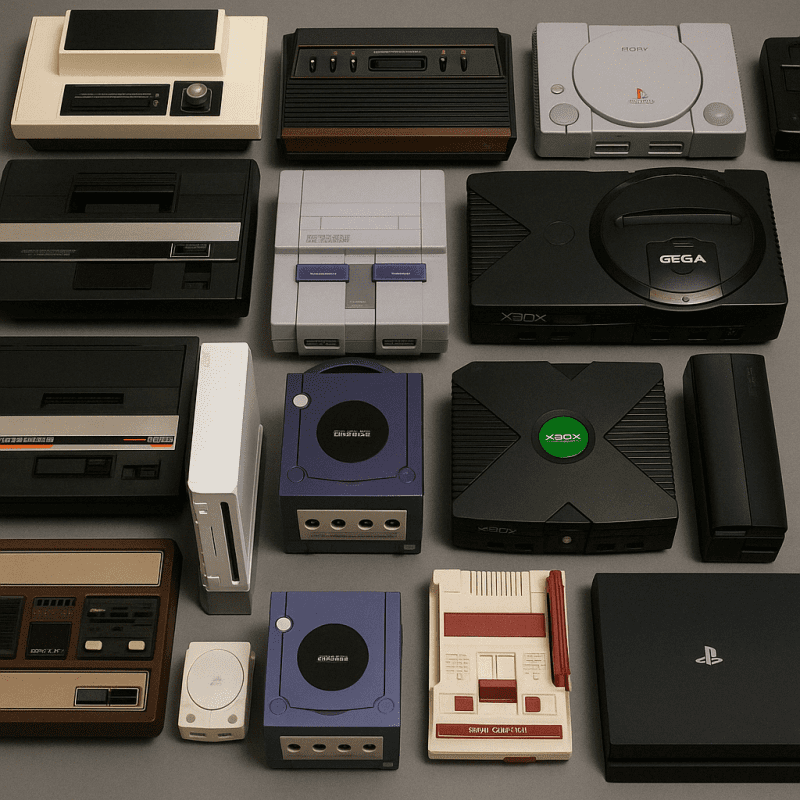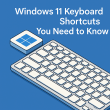Table of Contents Show
If you’ve ever tried to map out the evolution of video game consoles, you know it’s not just a straight line – it’s a crazy, twisting journey full of innovation, corporate rivalries, hits, misses, and some truly bizarre hardware choices. But one thing’s for sure: every generation brought something new to the table, whether it was 3D graphics, online play, motion controls, or just a better way to blow into cartridges. Here’s a comprehensive, generation-by-generation breakdown of every notable games console to date. (Caveat: there are SO MANY consoles from over the years, there are weird and whacky consoles from across the world I haven’t listed. If I haven’t featured your favorite, leave a comment below.)
First Generation (1972–1980)
This era was the wild west of gaming. Most consoles were dedicated systems – that is, they played only a fixed number of games, usually variations of Pong. Graphics were basic (think white lines and squares), but this generation laid the groundwork for the multi-billion-dollar industry we know today.
| Console | Manufacturer | Release Year |
|---|---|---|
| Magnavox Odyssey | Magnavox | 1972 |
| Home Pong | Atari | 1975 |
| Color TV-Game | Nintendo | 1977 |
| Telstar Series | Coleco | 1976 |
| VideoSport MK2 | Henry’s | 1974 |
Most of these were pretty short-lived, but they taught the world one key lesson: interactive entertainment was the future.
Second Generation (1976–1992)
This is when consoles started using ROM cartridges, allowing you to swap games in and out. It also brought more powerful graphics, color displays, and early game franchises.
| Console | Manufacturer | Release Year |
|---|---|---|
| Fairchild Channel F | Fairchild | 1976 |
| Atari 2600 | Atari | 1977 |
| Intellivision | Mattel | 1979 |
| Odyssey 2 | Magnavox | 1978 |
| ColecoVision | Coleco | 1982 |
The Atari 2600 was the MVP of this generation. It gave us classics like Pitfall, Space Invaders, and Adventure.
Third Generation (1983–1990)
Known as the 8-bit era, this generation introduced more complex gameplay, improved graphics and sound, and the birth of some of the most enduring franchises in gaming history.
| Console | Manufacturer | Release Year |
|---|---|---|
| Nintendo Entertainment System (NES) | Nintendo | 1983 (Japan), 1985 (US) |
| Sega Master System | Sega | 1985 |
| Atari 7800 | Atari | 1986 |
The NES dominated globally, especially in North America. It introduced Super Mario Bros., The Legend of Zelda, and Metroid. The third generation is often credited with reviving the gaming industry after the 1983 crash.
Fourth Generation (1987–1996)
Welcome to the 16-bit era. This generation was marked by fierce competition between Sega and Nintendo, leading to a golden age of gaming creativity and innovation.
| Console | Manufacturer | Release Year |
|---|---|---|
| Super Nintendo Entertainment System (SNES) | Nintendo | 1990 |
| Sega Genesis / Mega Drive | Sega | 1988 |
| TurboGrafx-16 | NEC | 1987 |
| Neo Geo | SNK | 1990 |
This generation saw an explosion of beloved titles like Chrono Trigger, Sonic the Hedgehog, and Street Fighter II.
Fifth Generation (1993–2001)
3D graphics became the standard. Polygonal models replaced sprites, and CD-ROMs replaced cartridges in many cases. It was a time of experimentation and new player entries.
| Console | Manufacturer | Release Year |
|---|---|---|
| Sony PlayStation | Sony | 1994 |
| Nintendo 64 | Nintendo | 1996 |
| Sega Saturn | Sega | 1994 |
| Panasonic 3DO | Panasonic | 1993 |
| Atari Jaguar | Atari | 1993 |
The PlayStation changed everything, becoming the first console to sell over 100 million units. Nintendo stuck with cartridges, which hurt third-party support, but it still delivered classics like Super Mario 64 and Ocarina of Time.
Sixth Generation (1998–2013)
Now we get into online connectivity, DVD support, and a big jump in processing power. Consoles started to resemble home entertainment hubs.
| Console | Manufacturer | Release Year |
|---|---|---|
| Sega Dreamcast | Sega | 1998 |
| PlayStation 2 | Sony | 2000 |
| Xbox | Microsoft | 2001 |
| Nintendo GameCube | Nintendo | 2001 |
The PS2 remains the best-selling console of all time with over 155 million units sold. The Dreamcast was ahead of its time (online play!), but Sega exited hardware soon after.
Seventh Generation (2005–2017)
High-definition graphics, online multiplayer, downloadable content, and motion controls defined this generation.
| Console | Manufacturer | Release Year |
|---|---|---|
| Xbox 360 | Microsoft | 2005 |
| PlayStation 3 | Sony | 2006 |
| Nintendo Wii | Nintendo | 2006 |
The Wii sold over 100 million units, attracting casual gamers with its motion controls. Meanwhile, the PS3 and Xbox 360 battled it out with blockbuster franchises and HD visuals.
Eighth Generation (2012–Present)
This is the generation of digital downloads, subscriptions, streaming, and 4K gaming. Physical media started to take a backseat.
| Console | Manufacturer | Release Year |
|---|---|---|
| Wii U | Nintendo | 2012 |
| PlayStation 4 | Sony | 2013 |
| Xbox One | Microsoft | 2013 |
| Nintendo Switch | Nintendo | 2017 |
The Wii U struggled, but the Switch (a hybrid console/handheld) more than made up for it, surpassing 130 million units sold as of 2025. PS4 had a phenomenal run, with hits like The Last of Us Part II and God of War.
Ninth Generation (2020–Present)
This is where we are now: faster load times thanks to SSDs, ray tracing, and seamless game streaming are becoming the norm.
| Console | Manufacturer | Release Year |
|---|---|---|
| PlayStation 5 | Sony | 2020 |
| Xbox Series X/S | Microsoft | 2020 |
These consoles are still going strong, and both are essentially mini gaming PCs. They support backward compatibility, cloud gaming, and increasingly digital-first ecosystems.
Honorable Mentions & Handhelds
Though not part of the home console lineup per se, handheld consoles deserve some serious love. Some were so influential they reshaped gaming on their own:
| Console | Manufacturer | Release Year |
|---|---|---|
| Game Boy | Nintendo | 1989 |
| Game Boy Advance | Nintendo | 2001 |
| Nintendo DS | Nintendo | 2004 |
| PlayStation Portable (PSP) | Sony | 2004 |
| PlayStation Vita | Sony | 2011 |
Nintendo absolutely dominated the handheld scene, with over 150 million DS units sold. The PSP held its own, especially in Japan.
What the Future Holds
Console generations are becoming less distinct. With services like Xbox Game Pass and PlayStation Plus Premium offering massive libraries and cloud streaming, the “console” is slowly being abstracted. Even Valve’s Steam Deck blurs the line between console and PC.
Expect tighter PC-console integration, more subscription-based models, and possibly even devices that look nothing like the traditional game console. The rise of handheld PCs like the ASUS ROG Ally and Lenovo Legion Go is already shaking up the scene.
For more on console history, check out this deep dive:
Whether you’re a hardcore retro collector or someone who just picked up a PS5, there’s no denying the impact of these boxes of silicon and plastic. They’ve changed entertainment, culture, and probably a few report cards along the way.








